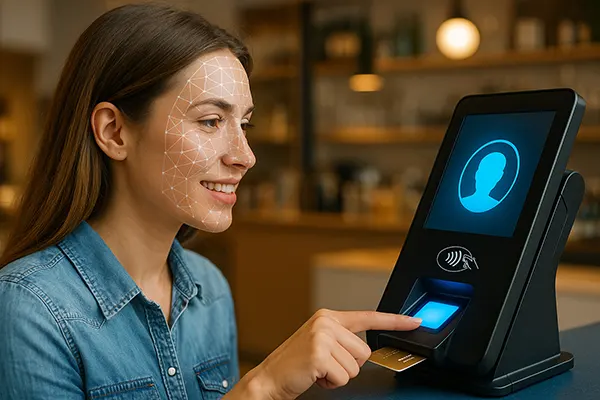
Biometric Payments Without Cards — How Safe Are They?
Biometric payments are no longer a futuristic idea but a reality in many parts of Europe and beyond. Instead of carrying physical cards, consumers can now complete transactions with a fingerprint, face scan or even voice recognition. This shift towards biometric authentication raises important questions about security, convenience and compliance with European data protection regulations. In 2025, as these methods become increasingly common, understanding their benefits and risks is essential for both businesses and consumers.
The Rise of Biometric Payments
The adoption of biometric technology in payment systems has accelerated due to the demand for contactless solutions and faster transactions. Major banks and retailers are integrating face recognition and fingerprint readers into their checkout processes, reducing reliance on cards and PIN codes. These systems are supported by mobile devices, smartwatches and dedicated biometric scanners.
One of the biggest drivers of this trend is consumer convenience. People are drawn to the simplicity of paying with a touch or glance, eliminating the need to remember passwords or carry multiple cards. In addition, biometric methods are considered harder to forge compared to traditional magnetic stripe or chip cards.
Industry analysts note that the European market is particularly receptive, with pilot programmes launched in countries such as France, the UK, and Germany. These projects test the balance between convenience and compliance with strict data protection laws.
Advantages for Consumers and Businesses
Biometric payments offer enhanced security by linking transactions to unique physical characteristics that are difficult to replicate. This significantly reduces fraud risks associated with stolen cards or compromised PINs. For businesses, adopting biometric systems can mean faster checkouts and improved customer satisfaction.
Another advantage is accessibility. For individuals who may struggle with remembering PIN codes or managing physical wallets, biometric methods provide a straightforward and user-friendly solution. This makes financial services more inclusive, particularly for elderly or disabled users.
Finally, biometric systems create opportunities for seamless integration with digital wallets, loyalty programmes, and personalised shopping experiences. By connecting identification and payment in a single step, retailers can streamline operations while offering tailored services to customers.
Risks and Security Challenges
Despite their benefits, biometric payments are not without risks. One key concern is the permanence of biometric data. Unlike a password, fingerprints and facial features cannot be changed if compromised. A data breach involving biometric identifiers can therefore have long-lasting consequences for individuals.
Cybersecurity experts warn that attackers may attempt to spoof biometric systems using advanced technologies such as 3D masks or synthetic fingerprints. While payment providers continue to strengthen their defences, the threat landscape is evolving rapidly, and criminals often adapt faster than regulations.
Moreover, storing and processing biometric data introduces new challenges for companies. They must ensure that sensitive information is encrypted, stored securely, and handled in compliance with European data protection standards. Any failure to do so risks both financial penalties and reputational damage.
GDPR and Regulatory Considerations
In the European Union, biometric data is classified as sensitive personal information under the General Data Protection Regulation (GDPR). This means companies handling such data must comply with strict rules on consent, data minimisation and security. Consumers must be clearly informed about how their biometric information is used and stored.
Under GDPR, organisations are required to demonstrate a lawful basis for processing biometric data, often relying on explicit consent. They must also implement data protection by design, ensuring that privacy safeguards are built into systems from the outset rather than added as an afterthought.
Regulators across Europe continue to monitor the sector closely. Enforcement actions have already been taken against companies that misused biometric technologies, signalling that compliance is not optional. For businesses, this underlines the importance of investing in secure systems and transparent communication with users.

The Future of Biometric Payments
Looking ahead, biometric payments are likely to become even more widespread, integrated into everything from public transport systems to e-commerce platforms. Advances in artificial intelligence and machine learning will make these systems faster, more accurate and harder to deceive.
At the same time, collaboration between financial institutions, regulators and technology providers will be crucial. Standards must be established to ensure interoperability across borders while maintaining high levels of security and consumer trust. This will help create a harmonised approach to biometric payments in Europe.
For consumers, the key will be balancing convenience with awareness of potential risks. Educating users about best practices — such as enabling multi-factor authentication and monitoring account activity — can help strengthen security while allowing them to enjoy the benefits of cardless payments.
Balancing Innovation and Trust
The future of biometric payments depends on striking the right balance between technological progress and consumer protection. While innovation continues to drive new opportunities, trust remains the foundation of adoption. Without confidence in security and privacy, consumers are unlikely to fully embrace these solutions.
Businesses must therefore prioritise transparency, clearly explaining how biometric data is collected, stored and protected. By doing so, they can reassure customers and foster long-term loyalty in a competitive market. Trust is not only a regulatory requirement but also a business advantage.
As Europe leads the way in responsible innovation, biometric payments may set a global standard for combining convenience, inclusivity and robust protection. The challenge will be maintaining this balance as technologies evolve and new threats emerge.


